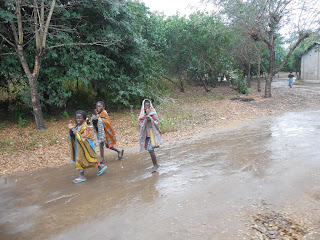During the middle of our week in Gorongosa National Park in
Mozambique, we left the park to visit Nhambita Village. Our first stop was an agriculture project
supported by the park. We saw a
demonstration garden where people learned how to do sustainable gardening. It was done all by hand. We listened to the men who ran the project
while some of the women stood nearby.
Unfortunately, it had begun to rain (and we were supposed to be in the
dry season) so we tried to listen attentively while at the same time attempting
to keep dry.
The rain continued as we drove to our next stop.
People waved to us as we drove by.
The children were especially friendly.
These people live in extreme poverty; we are
rich in comparison.
Rain formed huge
puddles, ponds even, around the little houses.


When we finally arrived at the school some of us were
drenched despite the ponchos we were given.
The canopies on our vehicles would collect water and then at times dump
it on us through the open sides. By the
time we arrived, I looked like a drowned rat.
However, once we stopped and entered the school building, our attention
was on the children.
The school was not in session at this time. We met with girls from the Girls Club. We sat at the back of the classroom as they welcomed
us. An adult leader told us about the
club and the girls. The girls sang and
danced for us. We were delighted. And then it was our turn.




We brought out the bags containing the shoes that grow.
The bag I had carried still had not arrived
and neither had two other bags of shoes, but enough had arrived for us to hand
out these amazing shoes.
The shoes,
which were made in Nampa, Idaho, are designed to lengthen and widen as the
child’s foot grows.
The girls quietly
lined up for a pair of shoes.
I looked
at their feet—they were either barefoot or they were wearing very thin, cheap
flip flops.
We took turns handing out
the shoes.
When it was my turn, I handed
a pair of shoes to several shy girls with the most beautiful smiles.
For me, this was one of the highlights of our
trip.
(For more information about these
wonderful shoes, go to
https://theshoethatgrows.org/.
Help distribute shoes to kids or make a donation.)
















Once we left the school, we headed for the Community
Education Center. We received a short
presentation about the center before sitting down to a delicious lunch. There were people from the community present
for lunch also. After lunch we toured
the center which includes dormitories.
One of my favorite spots was the area where they make honey. We saw the hives and the small little
building, which is more like a closet, where the honey is processed. The honey is sold in the park so before we
left Gorongosa, I bought a jar of this honey to bring home. (And yes, it is delicious.)


















































